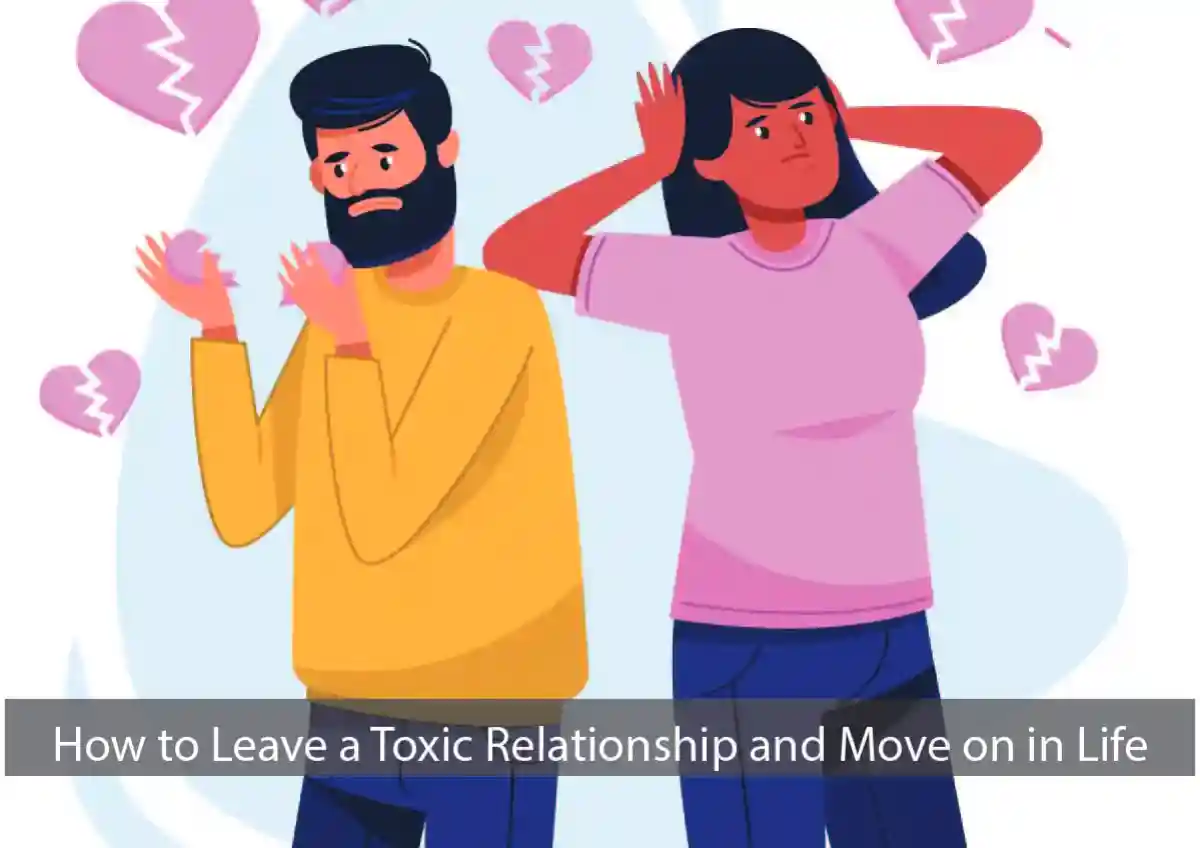Are you feeling trapped in a toxic relationship and desperate to break free? This guide will provide the essential steps on how to leave a toxic relationship in that harmful environment and start a new chapter in your life. Freeing yourself from a toxic relationship is not easy, but it is necessary for your well-being and happiness. Regarding relationships, we all hope for love, support, and joy. However, not all relationships are healthy, and some can become toxic. Understanding what constitutes a poisonous relationship is crucial to recognizing the signs and taking steps toward leaving.
A toxic relationship is characterized by behaviors and dynamics damaging one’s well-being. It may involve emotional, physical, or verbal abuse, manipulation, control, or constant negativity. In a toxic relationship, you may feel drained, anxious, and unhappy. It is important to remember that you deserve better and have the right to leave a toxic relationship.
1. Signs It’s Time to Leave a Toxic Relationship
Leaving a toxic relationship is not an easy decision, but it’s necessary for your well-being and happiness. Here are some signs that indicate it’s time to leave:
- Lack of respect and trust: If your partner consistently disrespects your boundaries, lies to you, or breaks your trust, the relationship is toxic.
- Emotional and physical abuse: Any form of abuse, whether it’s verbal, emotional, or physical, should never be tolerated. Your safety and well-being should always be your top priority.
- Feeling constantly drained: Toxic relationships are emotionally exhausting. If you find yourself constantly drained, anxious, or stressed whenever you’re around your partner, it’s a sign that the relationship is toxic.
- Lack of growth and support: In a healthy relationship, both partners should support each other’s dreams and personal development. If your partner consistently undermines your goals and aspirations, it’s a sign of toxicity.
- Feeling isolated: Toxic partners often isolate their victims from friends and family, leaving them feeling alone and dependent. If you find yourself cut off from your support system, it’s a sign of a toxic relationship.
Recognizing these signs and acknowledging that it’s time to leave is the first step toward regaining control of your life.
2. Preparing for the Breakup
Leaving a toxic relationship requires careful planning and preparation. Here are some steps to help you create a safe exit plan:
- Gather evidence: If you’re facing physical or emotional abuse, it’s essential to gather any evidence that can support your case. This can include photographs of injuries, text messages, or any other form of documentation that can prove the toxicity of the relationship.
- Secure your finances: Financial independence is crucial when leaving a toxic relationship. Start saving money in a secret account, and ensure you have access to necessary documents like IDs, bank statements, and insurance papers.
- Find a safe place to stay: If you fear your safety, make arrangements to stay with a trusted friend or family member. If that’s not possible, research local shelters or safe houses that can provide temporary accommodation.
- Create a support network: Reach out to friends, family, or support groups who can offer emotional support during this difficult time. A strong support network will help you stay strong and motivated.
- Notify authorities if necessary: If you’re facing physical abuse or threats, it’s essential to involve the authorities. They can provide protection and support during the breakup process.
By taking these steps, you’ll be better prepared to leave the toxic relationship and start a new chapter in your life.
3. Seeking Support from Friends and Family
Leaving a toxic relationship can be an emotionally challenging journey, and having the support of loved ones is crucial. Contact your trusted friends and family and let them know what you’re going through. They can provide a listening ear, offer advice, and help you stay strong during this challenging time.
It’s essential to surround yourself with people who uplift and support you. Avoid negative influences that may undermine your decision or bring you down. Seek out support groups or online communities of individuals who have gone through similar experiences. Sharing your story with others who understand can be incredibly healing and empowering. Remember, you don’t have to go through this alone. Seeking support from friends and family is vital in leaving a toxic relationship.
4. Setting Boundaries and Creating a Support System
Leaving a toxic relationship is just the first step. Setting clear boundaries with your ex-partner is crucial to ensure your safety and well-being. Here are some critical steps to consider:
- Cut off contact: If possible, completely cut off contact with your ex-partner. This includes blocking their phone number, unfollowing them on social media, and deleting any mutual friends who may still have contact with them. Removing their presence from your life will help you heal and move on.
- Create a safety plan: If you’re concerned about your ex-partner’s reaction to the breakup, create a safety plan. This can include changing locks, installing security cameras, and informing trusted friends and family about your situation.
- Seek professional help: Consider seeking therapy or counseling to help you navigate the emotional aftermath of leaving a toxic relationship. A trained professional can help you process your feelings, rebuild your self-esteem, and develop healthy coping mechanisms.
- Focus on self-care: Take time to prioritize your well-being. Engage in activities that bring joy, practice self-compassion, and prioritize self-care. Remember, healing takes time, and it’s essential to be patient with yourself.
Setting these boundaries and creating a solid support system will help you rebuild your life after leaving a toxic relationship.
5. Taking Care of Your Mental and Emotional Well-being
Leaving a toxic relationship can take a toll on your mental and emotional well-being. It’s important to prioritize self-care and take steps to heal. Here are some strategies to help you on your journey:
- Practice self-compassion: Be kind and acknowledge that leaving a toxic relationship is a brave decision. Remind yourself that you deserve love, respect, and happiness.
- Seek professional help: Consider working with a therapist or counselor specializing in trauma and relationship issues. They can provide the tools and support you need to heal and move forward.
- Engage in self-care activities: Find activities that bring you joy and help you relax. This can include exercise, meditation, journaling, or pursuing hobbies that make you feel fulfilled.
- Surround yourself with positivity: Positive influences, uplifting books, podcasts, or supportive friends. Fill your environment with positivity to counteract the negativity from your past relationship.
Taking care of your mental and emotional well-being is a crucial part of the healing process after leaving a toxic relationship.
6. Healing and Moving On After Leaving a Toxic Relationship
Leaving a toxic relationship is a significant step, but the healing process doesn’t end there. It’s important to give yourself time to heal and mourn the loss of the relationship. Here are some strategies to help you on your journey to healing:
- Practice forgiveness: Forgiveness is not about excusing the toxic behavior or reconciling with your ex-partner. It’s about letting go of the anger and resentment that may hold you back. Forgiving yourself is also essential, allowing you to move forward without carrying unnecessary guilt.
- Focus on personal growth: Use this opportunity to discover yourself and grow. Set new goals, explore new interests, and invest in personal development. Embrace the freedom to become the best version of yourself.
- Surround yourself with positive influences: Surround yourself with people who uplift and support you. Engage in activities that bring you joy and help you rediscover your passions. Surrounding yourself with positivity will help you build a brighter future.
- Seek healthy relationships: Apply the lessons learned from your toxic relationship to future relationships. Set clear boundaries, communicate openly, and prioritize your well-being. Remember, you deserve a healthy and loving relationship.
Healing and moving on after leaving a toxic relationship takes time, but with patience and self-care, you can build a brighter future.
7. Rebuilding Your Life After Leaving a Toxic Relationship
Leaving a toxic relationship is a courageous step towards reclaiming your life. However, the journey doesn’t end there. Rebuilding your life after leaving a toxic relationship is essential for your healing and growth. Here are some tips to help you along the way:
- Focus on self-care: Prioritize your physical and emotional well-being. Engage in activities that bring you joy and make time for self-reflection and healing.
- Set boundaries: Clearly define your limits and communicate them to others. Learn to say no and prioritize your own needs and wants.
- Seek therapy: Working with a therapist can help you process your emotions, heal from the trauma, and develop healthier relationship patterns.
- Surround yourself with positivity: Surround yourself with supportive and uplifting people who believe in your strength and encourage your growth.
- Rediscover your passions: Take time to explore your interests and hobbies. Reconnecting with your passions can help you regain a sense of identity and purpose.
8. Learning from the Experience and Avoiding Similar Relationships in the Future
Leaving a toxic relationship is a powerful opportunity for growth and self-reflection. Take the time to reflect on the patterns and behaviors that led you into that toxic relationship. Here are some steps to help you avoid similar relationships in the future:
- Identify your needs and values: Understand your needs and boundaries. This self-awareness will help you recognize when a relationship is not aligned with your core values and enable you to make healthier choices.
- Set clear boundaries: Establish boundaries from the beginning of any new relationship. Communicate your expectations and make sure they are respected. Don’t be afraid to walk away if someone crosses those boundaries.
- Trust your instincts: Trust your gut instincts regarding new relationships. Listen to your intuition if something doesn’t feel right or if you notice any red flags. Your instincts are there to protect you.
- Take it slow: Allow relationships to develop naturally and at a pace that feels comfortable for you. Rushing into a new relationship can close your eyes to potential warning signs.
- Continued self-care: Make self-care a priority even after leaving a toxic relationship. Engage in activities that promote self-love, self-discovery, and personal growth. Taking care of yourself will help you attract healthier relationships.
By learning from your experience, setting boundaries, and prioritizing self-care, you can avoid falling into similar toxic relationships in the future.
Conclusion
Leaving a toxic relationship is a courageous and empowering decision. By recognizing the signs of toxicity, creating a safe exit plan, and prioritizing your well-being, you can break free from the chains of a toxic relationship and embark on a new chapter in your life.
Remember, you are worthy of love, respect, and happiness. Surround yourself with positive influences, seek support from loved ones, and invest in your personal growth. By learning from your past experiences, you can avoid falling into similar toxic relationships in the future. Embrace the opportunity to heal, grow, and create a healthier future for yourself. You deserve nothing less than a love, respect, and happiness and healthy relationship. Take that first step towards freedom and start building the life you truly deserve.








